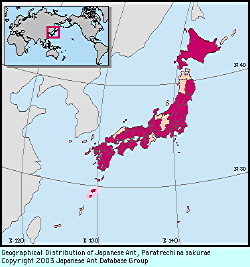
|
species
|
Paratrechina sakurae
|
 |
Original Reference
|
|
Ito, T. (1914) Formicidarum Japonicum species novae vel minus cognitae. Annales de la Société Entomologique de Belgique 58: 40-45.
|
Synonym
|
|
Prenolepis sakurae Ito (Ito, 1914) ,
Paratrechina sakurae (Ito)(Emery, 1925) ,
|
Description
|
|
Small ants, total length of workers around 1 - 1.5 mm. Body color brown; antennae and legs yellowish brown. Easily separated from other Japanese Paratrechina species by the short antennal funiculi (with 2nd to 4th segments each wider than long). Mandibles with 6 teeth. Scapes exceeding posterior margin of head by twice their individual width; lacking erect hairs. Three ocelli present but obscure. Mesosoma short, about as long as head. Promesonotal dorsum convex in profile, the slope of pronotal dorsum steeper than that of mesonotum. Propodeal dorsum short. Metanotal groove shallow and short. Pronotal and propodeal dorsa each with a pair of erect hairs. Hind femora and tibiae without erect hairs.
|
Remarks
|
|
Nests are found in rotting wood, leaf-litter and under stones in drier habitats than P. flavipes. Nuptial flights occur in October and November. A widely distributed species.
|
|

Distribution
|
|
Hokkaido, Honshu, Shikoku, Tsushima I., Kyushu, Yaku I., Nansei Is (Tokunoshima I. and northwards); Korean Peninsula.
|
|
References
|
|
- Formicidarum Japonicum species novae vel minus cognitae. Annales de la Société Entomologique de Belgique 58: 40-45.
- Emery, C. (1925). Hymenoptera, Formicidae, Formicinae. . In M. P. Wytsman, ed., ""Genera Insectorum"", fasc. , 183, 1-302.
|
Editor
|
|
Original text by Keiichi Onoyama, Masaaki Morisita & Mamoru Terayama. English translation by Mamoru Terayama, edited by Robert W. Taylor.
|
|